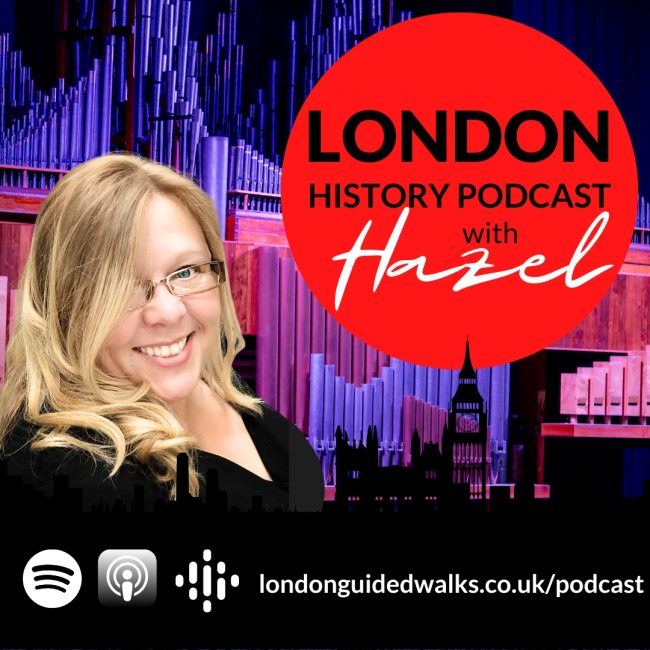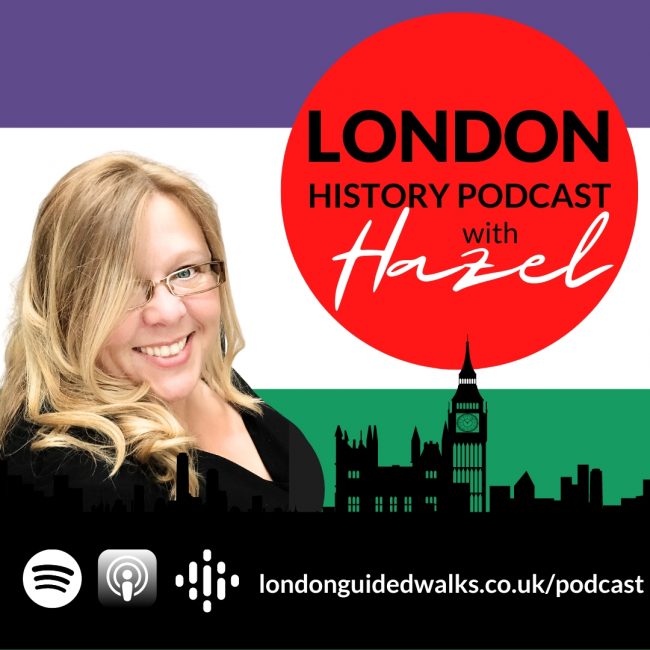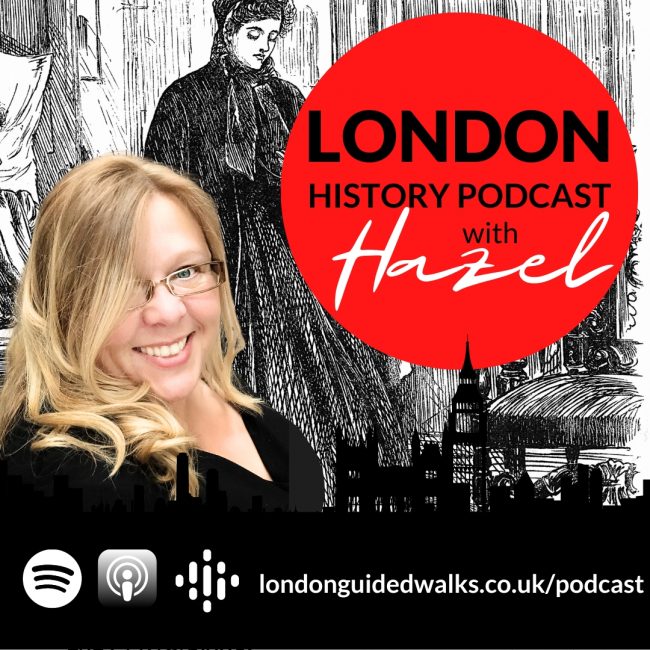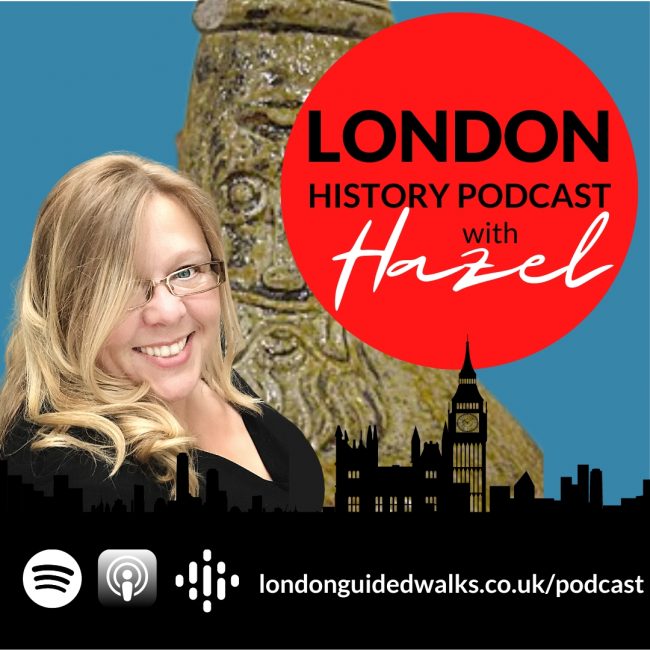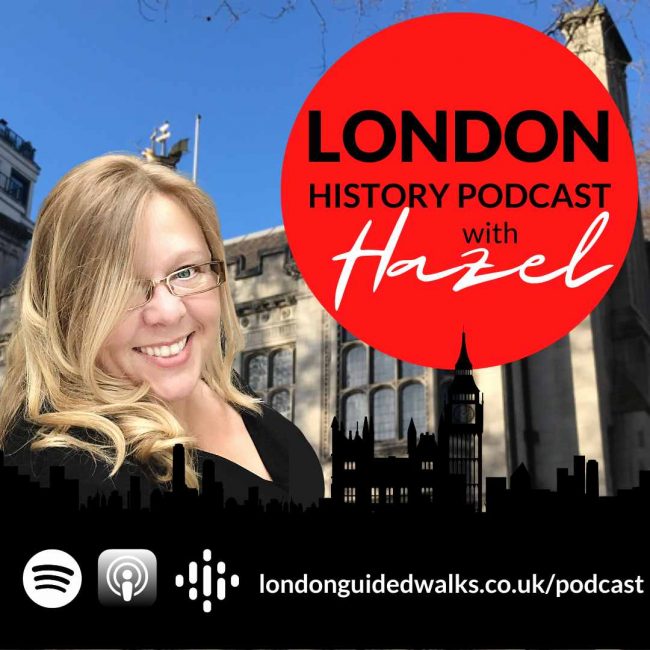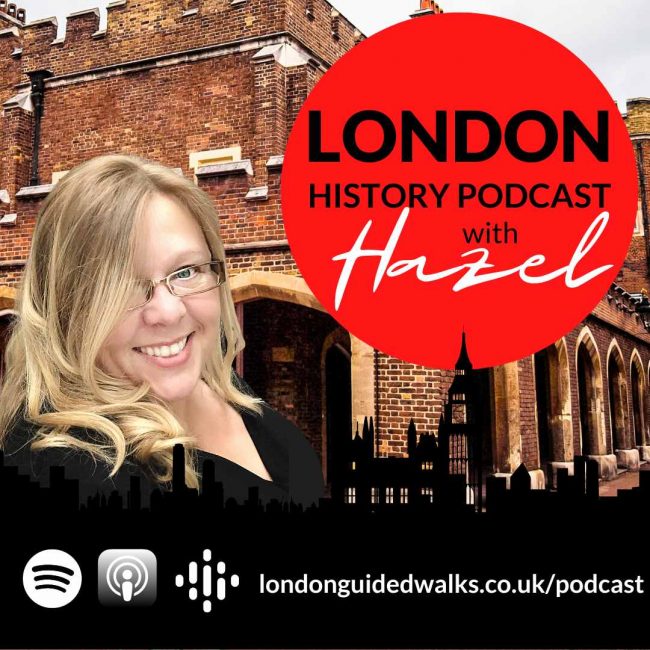London’s Coffeehouses and Commerce
Recommended Reading:
Show Notes:
 Hazel Baker: Hello and welcome to London Guided Walks London History podcast. In the coming episodes, we will be sharing our love and passion for London, its people, places and history in an espresso shot with a splash of personality. For those of you who don’t know me, I am Hazel Baker, founder of London Guided Walks, providing guided walks and private tours to Londoners and visitors alike.
Hazel Baker: Hello and welcome to London Guided Walks London History podcast. In the coming episodes, we will be sharing our love and passion for London, its people, places and history in an espresso shot with a splash of personality. For those of you who don’t know me, I am Hazel Baker, founder of London Guided Walks, providing guided walks and private tours to Londoners and visitors alike.
Joining me today is Ian McDiarmid, City of London tour guide and financial London lecturer.
When did the City of London take off as a financial centre?

Ian McDiarmid: Well, that’s a very good question. I think London has always dominated England finance, but it really takes off as an international financial centre in the modern sense in the late 17th and early 18th centuries.
And this is a period that historians described sometimes as the financial revolution. And really it’s a period when the financial markets gets going and London really takes off as a centre for international finance.
What was this financial revolution and why aren’t we taught about it at school?
Ian McDiarmid: Well, it’s interesting why it’s not more widely taught at school. I think that reflects the fact that finance isn’t given the prominence in not just education, but in culture that it really deserves the city. For example, it is of enormous importance to the economy today. It’s the most important part of the British economy and yet a lot of people are relatively ill-informed about it and what it does, going back to the financial revolution itself, there are various components to it. There are institutional changes which are taking place, and we can identify here is the foundation of coffee houses, which are developers, places to do business in.
We can mention the founding of the Bank of England, which is of enormous importance and the development of a very important London institution The Royal Exchange, which I don’t think a lot of people are very familiar with. The Royal Exchange in the sense of they go past the building, but they don’t actually know what took place there.
In addition to these institutional changes, you crucially you get the development of the origins of modern markets. So the origins of modern markets in shares, bonds, insurance, commodities, all date back to this period and the other thing about the financial revolution is the fact that it mobilises England’s savings.
So in this period, particularly in the early 18th century, England is becoming the most successful economy in the world. There are the beginnings at this stage of changes in agricultural practice or so-called agricultural revolution, which makes, which will help make England’s agriculture much more efficient and leads to a relatively, very wealthy land-owning class.
But more importantly, probably you have the development of English overseas trade in this period. And it is in this period, the late 17th century and early 18th century, the English shipping begins too. Dominate world’s trade pre previous to this period. It had been the Dutch probably who had been the Supreme maritime power, but by the 18th century, you’ve got English ships appearing all over the world, including in the Baltic, which had up to that stage, really been, basically a Dutch Lake.
What’s the connection between shipping commerce and the city?
Ian McDiarmid: Well, essentially it means that the English merchants becoming extremely rich or some of them are, and some of their wealth, they want to invest. So before this period, before that the financial revolution, if you were in England, but pretty much anywhere, and you wanted to invest your wealth, you’d put it into land.
And with the financial revolution, you get the ability to, in economic speak, invest in financial securities. What does that mean? It means you can put your wealth into things like shares bonds, things that you can buy and sell very easily. And again, bit of jargon. That means that they’re liquid, you can buy and sell them easily.
And so in this period, you have a lot of very rich merchants seeking a home for their wealth. Yes, they’ll want to buy a landed estate, but along with other wealthy people, they want to diversify and. Begin to put their money into other forms of investment. And perhaps it’s worth speaking here a little bit about the dark side of English commerce here, which of course is the slave trade because one of the coffee houses was that that’s important in this story, which you can see in the heart of the city is the Jamaica.
Jamaica was where West Indian merchants meant. And the West Indian merchants were the. The wealthiest merchants. And there’s a lot of debate about how important slavery was to the English economy in the 18th century. But I think the answer is it was pretty important because by about 1800 sugar, which is the key asset key component of the triangle trade of which slaves are a part sugar accounts for fully 25% by value of English, English imports is absolutely huge.
So I was saying that you can see the Jamaica. What you’re looking at now is a modern popper. It’s actually a 19th century building, but the gin maker is on the site of an earlier coffee house. And that coffee house is actually on the site where coffee was first sold in London, back in 1652 by an enterprising Greek speaking man named Pasque Rosee.
Hazel Baker: Yes. I remember going there on your financial London tour, actually, it’s really quite remarkable, the history it’ll be good to understand a bit more about coffeehouses.
What were coffeehouses and why they were so important?
Ian McDiarmid: Well, the coffeehouses provided offices really in a period that didn’t have offices. The coffeehouse was a place where you would go. And the most important thing that from our point of view, that they would do there is to transact business. So in the Jamaica West Indian merchants would get together and they would do business with each other, but they were also important places just to meet like minded individuals and exchange opinions and exchange news.
They were more in a more formal sense. They were very important in the consumption and production of news because. They subscribed to the newspaper. So this period that we’re talking about is also the period of a great growth in newspaper publication, expansion of the production of newspapers and the newspapers would be subscribed to.
So you could go and read them in the coffeehouses, but also a lot of the news was actually produced in the coffeehouses. Themselves. And there were also places where you could get your mail forwarded to, and they were places of conviviality. There were places where people could go just not, not just to drink coffee, but also to drink, other things as well.
So Garraways, it was very well known at the time for it’s the quality of its cherry brandy and its sandwiches. But the central point obviously is that there are places where you can drink coffee and the great advantage of coffee is. In this period, it’s a drink that isn’t intoxicating and yet is safe to drink.
So before this time, a lot of people would be drinking. So-called small beer, small barrier is weak beer, and the alcohol is important because it kills off of the germs. But with coffee, you can, you’re obviously in a fit state to carry on doing business.
Hazel Baker: There’s another advantage to coffee that with the caffeine, it perks you up as well. It doesn’t make you go to sleep like alcohol does.
Ian McDiarmid: Well, Pascoe Roseé was a great propagandist in the cause of coffee and he asserted, there were all kinds of health benefits to it, which I think nowadays we would. Regardless being rather dubious, it’s also worth pointing out. Perhaps that 17th century coffee would have been extremely bitter to our tastes.
Now, Pascoe Rosee, who just to remind you is that is the man who is credited with first selling coffee in London. He starts off in 1652, and he’s very soon selling 600 dishes of coffee a day. Now, the fact he’s selling dishes of coffee indicates that. The consumption of coffee was a little bit different from the way we drink coffee.
Now it was filtered through oyster shells. As I say, the taste would be quite different and there’s a great quote from a contemporary. If I can remember it, he says something like the coffee tastes like the essence of all boot mixed with a syrup of such. I think we would probably agree with him if we were transported back in time to Pascoe Rosie’s coffee shack.
Hazel Baker: I have to say that I have the same feeling when I’m drinking Turkish coffee. That’s is not a particular love of mine.
Ian McDiarmid: I like Turkish coffee I think it’s good.
Hazel Baker: Talking about the importance of coffeehouses and links in with newspapers, and that’s where people would get their news. Because of course they don’t have Twitter feeds or anything at the time. And this is where we get the phrase to hear a pin drop as well. Isn’t it?
Ian McDiarmid: Yes, that’s right. So I was talking earlier about coffee houses, where merchants met and the importance of these for us story is simply that the merchants are one of the key elements providing the, the wealth behind the financial revolution, but more. Directly relevant to our story are the coffee houses that are dedicated to what we would call the trading of financial instruments and commodities.
And one of the coffeehouses is Garraways Coffee House and Garraways Coffee House was originally a coffee house where merchants from the Hudson Bay company would meet to auction off their pelts and then diversifies into a whole range of commodities, things like tea and auctions at Galloway’s would be by candle. And the way this would work would be that the auctioneer would have a pin and he would place that in a candle.
He would then light the candle and having lighted the candle. The auction process had begun. People could then at once the candle is lit, people could shout out their bids for whatever is being sold off. And then when, once the wick had burnt down to where the ping was, the auction period would be closed.
And the person who had put in the highest bid at that time would then be the lucky owner of the goods on sale. But it doesn’t always work like that. You can imagine that sometimes there would be some rather perhaps unsuccessful traders who weren’t very good at reading the market and they might’ve bought along the sick consignment of wine that day and nobody wanted really to buy it.
And so the auctioneer starts off the process. He likes the candle, he calls out for the bids to be made and. The room is silent and if the room was silent, it would be so quiet that you could hear a pin drop. I at the end of the auction period, the pin would drop out of the candle and fall into the little brass tray, I guess, beneath.
Hazel Baker: Awkward. So you’ve talked about Garraways Coffee House for commodities. What other ones were there?
Ian McDiarmid: Well, there was Jonathan’s, which was where people met to trade shares. And the most important shares at this period would be those of the bank of England and the East India company. And I was saying earlier how important the coffee houses were in the production and consumption of news.
Thanks to a French Huguenot immigrant ie, French Protestant immigrant, by the name of Carstaing there is everyday produced a list of prices of shares in London, which people within relatively easy reach of London can then keep a fairly close eye on the value of their investments and look at how shares are performing.
In addition, there is a Lloyd’s coffee house, which is perhaps the most famous of the mall. Lloyd’s actually starts off towards the tower of London, but then moves up to Lombard street. And there’s a little plaque on Lombard street saying the, the second Lloyd’s was, and Lloyd’s was a coffee house for insurance.
And the way shipping was the most important aspect of insurance markets at this time. And the way shipping insurance would work would be that you would write a ship’s name on a piece of paper. So the name of the ship goes at the top of the piece of paper, and then the people who want to insure it, write their name underneath.
And this is where we get the name underwriter from, and the way it would work is that you would underwrite, you would undertake to ensure perhaps an eight or a 12th of a ship you’d want to avoid thus avoiding the, the risks that would be entailed if you were ensuring an entire ship on your own.
So these are the. Three crucial ones, really, in terms of direct involvement for modern trading, the development of modern markets, and perhaps it’s worth spelling out that I’ve mentioned commodities, I’ve mentioned shares. I’ve mentioned insurance. London is the biggest market in all three of these areas still today within the European time zone.
Hazel Baker: So it all sounds so fascinating, but what happened to these coffee houses? Why have we now got Starbucks?
Ian McDiarmid: Well, I’m not quite sure why we’ve got Starbucks in terms of the demise of the coffee houses as placing as places for trading financial instruments and financial services. What happens in the 18th century and increasingly in the 19th century is you get the institutionalisation.
So. The share traders at a certain point, leave the premises of the coffee houses and they go off and they found the London stock exchange. The Jerusalem coffee house, which is one I haven’t mentioned yet is one which then later develops into the London metal exchange, which is still going strong. So there is, I think probably as the market develops, as it becomes more crowded, there are more people there, larger amounts of money.
The coffeehouses become too small. Two quaint you need larger premises and you also need the formalisation of organisations. You, you need to have regulation to keep the markets going and to try to keep a lid on fraud. You mentioned the bank of England before. Was it true that it was created to fund a war?
Yes, the bank of England is founded in 1694 with the principle objective of reducing the cost of English government debt. And this is incredibly important because England needs to borrow a lot because from this period on she’s involved in a long succession of Wars against the French and the. English government is able to borrow at rates much lower than the French government can.
And this is due largely to the bank of England. So the bank of England is set up in 1694 and the first tranche of money that it lends to the government comes from the sale of shares in itself to members of the public. So the bank of England raises a lot of money through selling shares that most of that money is then on lend to the government.
Yeah. After that the, the money raised by the bank of England is through the bank of England acting as the British government’s English governments, and then British government’s issuing agent. And this is when it issues bonds on behalf of the government. And this is an incredibly important role.
And what’s significant in England and later great Britain after the unification with, with Scotland is that it is parliament that controls the purse strings. And this is a system which people can have faith in. So MPS will be owners of british government debt and bank of England shares, perhaps more importantly, their constituents will be.
And so all these people have an interest in ensuring that this system carries on that the bank of England doesn’t go under. And this is in contrast to Europe and in particular France, which is England’s enemy where the French King and Louis XIIII. does this can simply declare bankruptcy. And if you are owned money by the King, that’s it, you’ve got no recourse whatsoever.
And as a result of that, the English are able to borrow more money, much more cheaper than the French do. And this is a key aspect in enabling them to sustain this long period of Wars against the French French economy is much, much bigger than the English economy. At the beginning of this period, France’s population is much, much larger than England, and yet.
Eventually over very, very long run, England is going to emerge victorious. And I think if you had suggested to Louis XIIII who had the English King, Charles II in his pocket, I mean, he was literally subsidising Charles II. If you’d mentioned to him that in a hundred or so years time, England would emerge victorious over France.
He’d probably look at you with disbelief. The bank of England plays an important role in this story. So this is how the body finally collapsed.
Hazel Baker: Isn’t this what happened with Edward III?
Ian McDiarmid: Yes though, from an earlier period, it’s very similar Edward III had an expensive series of Wars to finance. He Barrow, borrowed heavily from Florentine bankers in particular the Bardi and Peruzzi, he failed to pay them back and they collapsed and this caused a huge recession in Florence at the time.
Hazel Baker: And what about the Royal Exchange?
Ian McDiarmid: The Royal exchange is founded in the 16th century by Thomas Gresham. And it’s a place for merchants to meet undercover. And if you’d note, it’s still got the same design, it’s a 19th century building, but it’s got the outline of the earlier one. It and it consists of a courtyard. And the courtyard itself was demarcated into walks where merchants in various areas would meet. The importance for us though, is its a place around these merchants where financial trading develops and financial trading in bills of exchange, which are basically short term pieces of paper.
The modern equivalent of those is the money markets but also the foreign exchange market. Develops around these merchants obviously need foreign exchange to finance the import of foreign goods and to convert their earnings back into their own currency. And both these markets, the money markets and the foreign exchange markets are still enormously important to London.
Hazel Baker: Thanks very much for that.
Ian McDiarmid: You’re welcome.
Hazel Baker: You can join in and explore the heart of the capital’s financial markets and walk down the narrow alleyways, where the deals were done in the 17th to 19th century. The calendar for scheduled guided walks and private tours are both bookable.
If you’ve enjoyed this episode, then please do take a few moments and leave a review. It is very much appreciated. Thanks again, and see you next time.

 Hazel Baker: Hello and welcome to London Guided Walks
Hazel Baker: Hello and welcome to London Guided Walks 
